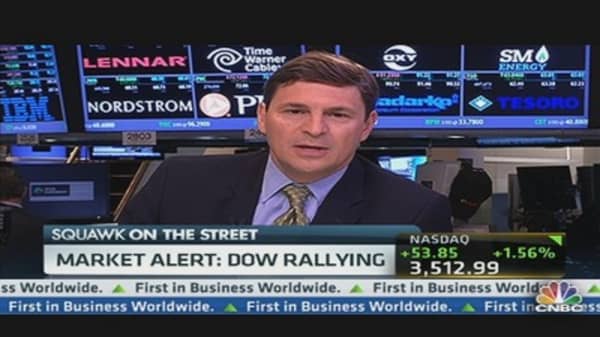Bausch & Lomb is by far Valeant's biggest acquisition to date, and will place it roughly among the 15 largest global pharmaceutical companies, said Valeant Chief Executive Michael Pearson in an interview with Reuters.
"This is a 160-year old company and brand name. I think we'll be able to really leverage that," he said, adding that the deal will boost Valeant's 2013 earnings.
Talks with Bausch & Lomb have been going on and off for a few years but intensified in recent weeks, Pearson said, adding that opthalmology is attractive for its growth prospects and Bausch & Lomb's large proportion of sales directly to consumers is also appealing.
Laval, Quebec-based Valeant plans to keep all three of Bausch & Lomb's segments of contact lenses, pharmaceuticals and surgical instruments, said Pearson, putting to bed some market speculation from Friday that the company may seek to sell the surgical instruments arm.
The Bausch & Lomb deal also gives Valeant the large scale of operations that it lacked in China and emerging markets like the Middle East, Pearson said.
"We are thrilled about the deal," said James Telfser, a portfolio manager at Caldwell Investment Management. "We are invested in Valeant right now, because we want something exposed to the U.S. and emerging markets and this definitely just beefs up that thesis."
Disciplined Strategy
"The reason we've always liked Valeant is because they have a disciplined acquisition strategy and they have been very clear all along that they are going to make another transformational deal, said Telfser, adding that Valeant accounts for 6.5 percent of the value of its Caldwell Canadian Value Momentum Fund.
Valeant has been on the acquisition trail since its 2010 takeover by Biovail Corp, which assumed the Valeant name.
It has been pursuing deals with strong cash flow in high-growth areas where big pharmaceutical companies have little presence. In opthalmology, however, Valeant will be competing more directly with heavyweights like Novartis AG, Allergan Inc and Johnson & Johnson.
Valeant, known for its prescription drugs such as anti-depressant Wellbutrin and over-the-counter remedies such as Cold-FX, has built up its dermatology and anesthetics portfolio in a dozen deals in the past year.
Last month Valeant attempted to acquire generic drugmaker Actavis Inc in an all-stock deal that would have topped $13 billion, according to sources familiar with the matter. Valeant, which has a market cap of about $26 billion, is likely to focus on integrating its new acquisitions for the rest of 2013, but will still look for smaller buys that fit its dermatology and opthalmology businesses, Pearson said.
"One of the key attractive attributes of Bausch & Lomb's business model is certainly the high level of private pay," said Canaccord analyst Neil Maruoka. "Valeant generally likes to avoid products and markets that receive a high level of government reimbursement."
Equity Financing
The brisk pace of acquisitions has pushed Valeant's debt to trailing EBITDA (earnings before interest, taxes, depreciation and amortization) to over four times, and the Bausch & Lomb deal will lever it up to 4.6 times, Pearson said. Cash flow and EBITDA should help bring that ratio to under four times, he said, which was previously Valeant's goal for 2013.
"Our M&A strategy, we believe is sustainable," Pearson said, adding that the company also pursues organic growth.
The deal, to be financed through debt and equity, will see some $4.5 billion go to an investor group led by Warburg Pincus LLC, with some $4.2 billion used to pay down Bausch & Lomb's outstanding debt.
Warburg Pincus stands to make close to three times its investment in Bausch & Lomb, according to a person familiar with the matter. Warburg Pincus declined to comment.
The deal will be financed with debt and about $1.5 billion to $2.0 billion of new equity, said Valeant, which has secured committed debt financing from Goldman Sachs.
Valeant expects the deal to result in at least $800 million in annual cost savings by end of 2014. This will come from job cuts, and savings in purchasing and legal costs, Pearson said.
Bausch & Lomb is expected to generate revenues of about $3.3 billion and adjusted earnings before interest, taxes, depreciation and amortization of about $720 million in 2013.
The company said Bausch & Lomb's CEO Brent Saunders will join Valeant in an advisory role to ensure a seamless transition and integration. Fred Hassan, Chairman of Bausch & Lomb's board of directors, will join Valeant's board following the close of the deal.
The transaction, expected to close in the third quarter, is subject to closing conditions and regulatory approvals. Valeant's legal advisors were Skadden, Arps, Slate, Meagher & Flom, and Osler, Hoskin & Harcourt. Bausch & Lomb was advised by Cleary Gottlieb Steen & Hamilton. Goldman Sachs and J. P. Morgan Securities acted as financial advisors to Bausch & Lomb on the deal.
AstraZeneca Buys Heart Firm Omthera
AstraZeneca is to buy Omthera Pharmaceuticals for as much as $443 million to build up its cardiovascular drug business, a priority area for Britain's second-biggest drugmaker.
The acquisition of the U.S.-based specialist in fish oil-derived medicine underscores a drive by new Chief Executive Pascal Soriot to revive AstraZeneca's fortunes through a series of bolt-on deals.
It is his second purchase in the cardiovascular field, following the acquisition last month of AlphaCore Pharma, a small early-stage U.S. biotechnology company.
The latest transaction pitches AstraZeneca into competition with rivals including GlaxoSmithKline that already sell heart-friendly fish oil drugs.
Omthera's leading drug has already completed final-stage clinical tests and has the potential to be combined with AstraZeneca's blockbuster cholesterol fighter Crestor. Helvea analyst Odile Rundquist said the deal was "a good move as it perfectly complements AstraZeneca's cardiovascular portfolio".
AstraZeneca's sales and profits are falling as older medicines lose patent protection and the company badly needs new products to replace former big sellers like the antipsychotic Seroquel, which lost exclusivity last year.
AstraZeneca said on Tuesday it had entered into a definitive agreement to buy Omthera for $12.70 per share, or approximately $323 million, a premium of 88 percent to Omthera's closing price on Friday.
In addition, Omthera shareholders will get "contingent value rights" (CVRs) of up to approximately $4.70 per share, or $120 million in total, depending on the success of Omthera's experimental drug Epanova, for treating patients with very high triglycerides, a type of blood fat that is bad for the heart.
CVRs are being used increasingly in deals in the pharmaceutical and biotechnology market to bridge differing expectations surrounding new drugs whose final sales are uncertain.
Shares in Omthera leapt 90 percent to $12.80 in premarket dealings on Nasdaq.
Seeking US Approval
Epanova is an ultra-pure mixture of the free fatty acid forms of eicosapentaenoic acid (EPA) and docosahexaenoic acid (DHA), derived from fish oil. It has already completed final-stage Phase III clinical trials and is set to be submitted for U.S. regulatory approval around the middle of this year.
The new drug will compete with other fish oil-based medicines such as GlaxoSmithKline's Lovaza and Amarin's recently approved Vascepa. AstraZeneca had, at one stage, been tipped as a possible buyer of Amarin.
Lovaza last year generated sales of 607 million pounds ($917 million) for GSK in the United States and Puerto Rico, where the company has marketing rights to the product.
Cardiovascular medicine is a key area for AstraZeneca, whose top-selling drug is Crestor. The British-based group said it intended to conduct a series of clinical studies testing a fixed-dose combination of Crestor and Epanova. The new combination, if successful, would extend the Crestor franchise beyond 2016, when the drug's U.S. patent ends.
AstraZeneca is also banking on another heart drug, Brilinta, to drive sales as older products go off patent.
Shares in AstraZeneca were up 3.2 percent at 3536.5 pence in a strong London stock market by 1054 GMT. In addition to news of the Omthera deal the stock was buoyed by news of a temporary blockage on U.S. sales of rival generic versions of its asthma drug Pulmicort Repsules, which was announced late on Friday.
The deal to buy Omthera has the backing of investors representing 60 percent of the Princeton, New Jersey-based company's shares. It is expected to close in the third quarter of 2013.





